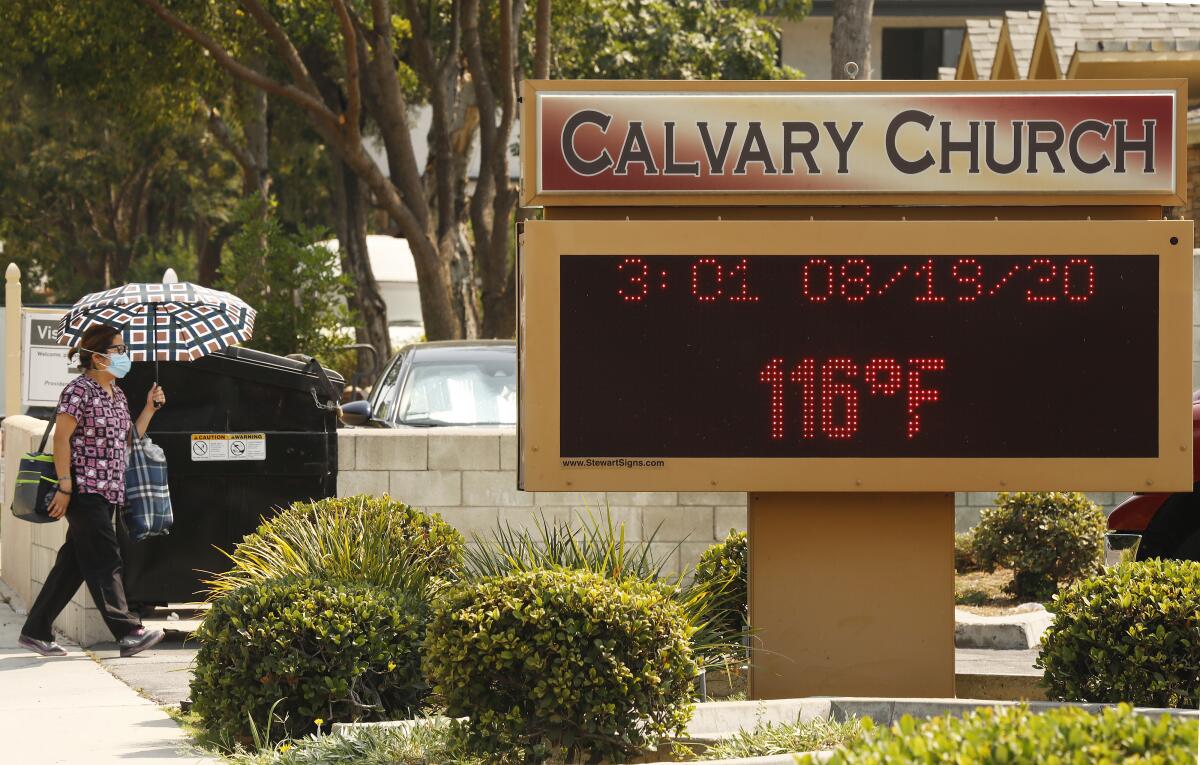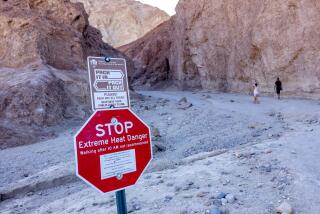Editorial: Heat kills. With climate change, we need to prepare for more deadly heat waves

- Share via
When most people think of deadly natural disasters, they probably imagine wildfires, floods, hurricanes and earthquakes. But last week’s record-breaking heat wave across the Pacific Northwest proved to be a quiet killer, causing hundreds of deaths across the ill-prepared region. Although the final toll has yet to be tallied, what we know already is shocking.
In Oregon, where the temperature hit an all-time high of 116 in Portland, there were at least 79 heat-related deaths. Washington, too, reported a spike in deaths, while emergency rooms and 911 systems were overwhelmed with heat-related illnesses. And in the Canadian province of British Columbia, where the village of Lytton hit 121 degrees — the highest temperature ever recorded in Canada — there were three times as many deaths as would typically occur during the same period.
These are just preliminary numbers. It can take time to determine what caused a person to die, and heat-related mortalities are typically undercounted. Because high temperatures exacerbate underlying health conditions, such as heart disease or diabetes, death certificates often don’t list heat as a cause of death. Still, extreme heat kills more people in an average year than any other weather-related hazard, including hurricanes and tornadoes, according to the National Weather Service.
The unprecedented nature and severity of the heat storm in the Pacific Northwest were major factors in the high death count. Oregon and Washington usually have mild summers, with highs in the 70s and 80s. Fewer than half the homes in Seattle have air conditioning. Last week, residents were suddenly plunged into several days of Death Valley-like heat for the first time ever. Of course, communities were overwhelmed and unprepared.
And yet the extreme temperatures and the deadly outcomes were also entirely predictable. Climate change has already ratcheted up average temperatures across the globe, slowly but steadily. Scientists have warned that we’ll see more extreme weather patterns, including intense heat waves that occur more frequently and for longer durations.
It’s time for the U.S. to start treating extreme heat as a hazard on par with hurricanes, tornadoes and floods. Too often heat waves are downplayed as a temporary inconvenience rather than what they are: a major public health risk that will only get worse as climate change takes hold.
That means preparing communities, medical systems and emergency personnel to be ready to respond to heat waves. It means seeking out the vulnerable to make sure they have the information and help necessary to protect themselves, including access to cooling centers or temporary housing if it’s not safe to stay where they are overnight. (Heat puts an enormous strain on the body when people cannot cool down at night.) Many of the dead in the Pacific Northwest were older people found alone in homes or apartments with no fans or air conditioning. There were also homeless individuals and laborers, who remained outside as the temperatures climbed.
We can’t wait until the next heat wave to act. State and local governments, including Los Angeles County’s, are beginning to draw maps identifying heat risk areas and vulnerable neighborhoods. They’re finding that low-income communities of color are most affected because they tend to have older housing without air conditioning and their neighborhoods lack trees and parks, creating a “heat island” effect that traps heat and stays hotter longer.
Public investments can help these communities become more heat resistant. Examples include planting more trees, creating parks and replacing some pavement with landscaped areas, using light-colored “cool” pavement and roofs, and installing bus shelters and other structures that provide shade.
There can also be targeted programs to weatherize homes in high-risk areas so they can better withstand the heat. Another option is installing solar panels on homes and apartment buildings and over parking spaces, which would provide shade, generate electricity and cut power bills.
Landlords are already required by law to ensure their properties have heat; perhaps they should also be required to provide cooling in areas at high risk of extreme temperatures. Yes, retrofitting apartments with air conditioning would be expensive, but in some areas having a cooling system may be the difference between life and death.
Climate change is here. More deadly heat waves are coming. We have to prepare for them.
More to Read
A cure for the common opinion
Get thought-provoking perspectives with our weekly newsletter.
You may occasionally receive promotional content from the Los Angeles Times.









